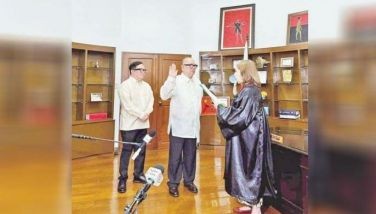Vanguards of the ‘50s
“Cinema should make you forget you are sitting in a theater.” — Roman Polanski
Although cinema was introduced to the Philippines way back in 1897 through the Lumiere cinematography, it was only much later that Filipino producer-directors Jose Nepomuceno and Vicente Salumbides actively pursued the art of filmmaking. It was in the 1930s with the arrival of the talkies or pictures with sound that the movie feature as we know it today finally became reachable by the mass audience.
After the World War II with the birth of the studios (LVN, Sampaguita and Premiere), Philippine cinema was well on its way to becoming the most popular means of entertainment in the country. The most brilliant of artists came up with their most imaginative works. Without access to funds and expensive gadgets, they were innovative and inventive. If the story called for a man on horseback riding towards a castle to save a damsel in distress, they would use a large transparent glass painted with a castle in the distance, and have the hero on horseback ride in front of the camera. It was painstaking work of precision, but anyone watching those costume pictures of old will marvel at how these directors managed the near impossible.
The studios each had developed their own audiences and fortes. The stars with Sampaguita under Dr. Jose R. Perez (Doc Perez) and Mommy Vera Perez were Gloria Romero, Rogelio de la Rosa, Pancho Magalona and Tita Duran, Amalia Fuentes, Romeo Vasquez and Susan Roces. The stories were often adapted from komiks serials, fantasies and tearjerkers.
LVN Pictures, run by Doña Narcisa vda. de Leon (Doña Sisang) and her son Manny held its own in costume pictures and comedies, with stars led by Leopoldo Salcedo, Lilia Dizon, Delia Razon, Mario Monetenegro, Nida Blanca and Nestor de Villa, Rosa Rosal and Charito Solis.
Lastly, Premiere Productions of the Santiago family — Ciriaco, Adela and later their son Cirio — may not have figured in the box-office race between Sampaguita and LVN, but it certainly led in the good reputation and awards its pictures brought for the company. It specialized in action pictures with Johnny Monterio, Jose Padilla Jr., Efren Reyes Sr., Zaldy Zshornack, Jose Romulo, Bob Soler, Danilo Montes, Eddie Fernandez and Fernando Poe Jr. under contract. But its most prized possession was the great Manong Gerry (Gerardo de Leon), National Artist for Cinema in 1982, a guru among directors, a cinematic magician who could come up with masterpieces of stunning visuals and messages.
Meanwhile, in 1951, Cahiers du Cinema (the influential French magazine) was founded, whose most famous writer-directors included Francois Truffaut, Jean Luc Godard and Claude Chabrol. Cahiers also championed the works of Jean Renoir, Roberto Rossellini and Max Ophuls, and led to the creation of a new wave in French cinema.
At the same time, their counterparts in the Philippines, who worked within the studio system, imposed an independence and dictatorship over their set that has yet to be duplicated in modern times. The first golden age of Philippine cinema had been born and three names led the path to excellence. They were Manuel Conde, Lamberto V. Avellana and Manong Gerry.
If these three were to be examples of the period, they were “bruskos” (harsh), self-confident, true auteurs at the exact period that the world was gaining adherence in France, although they were possibly unaware of it at the time.
(For comments, call 571-1569, e-mail at [email protected] or text 0917-8991835.)
- Latest
- Trending
































